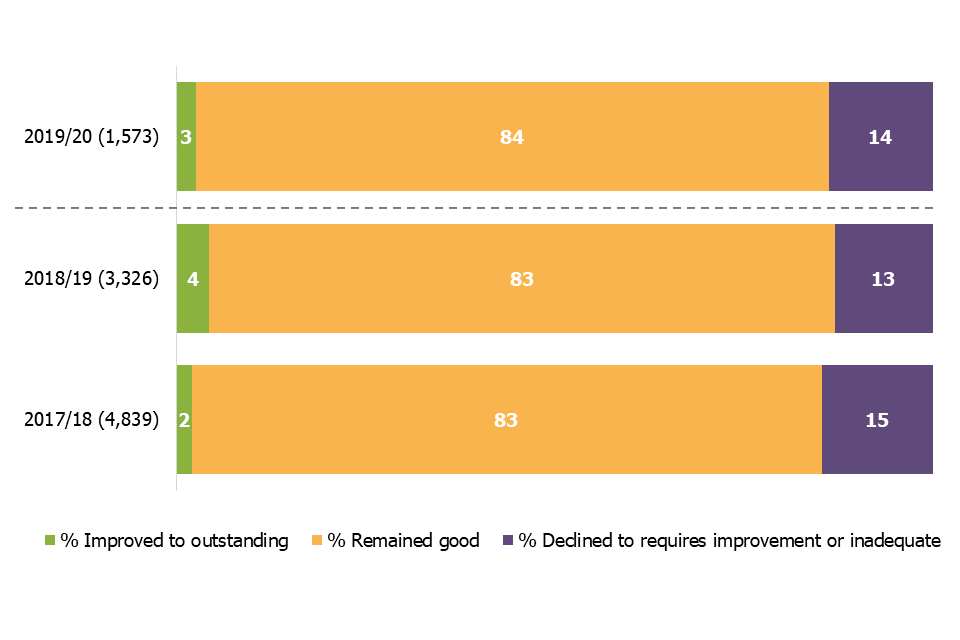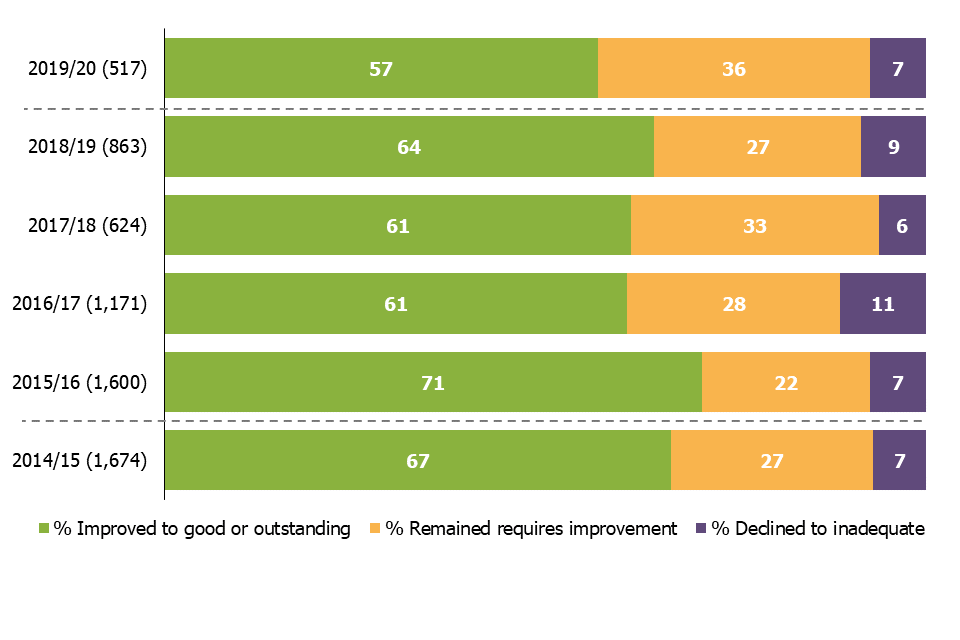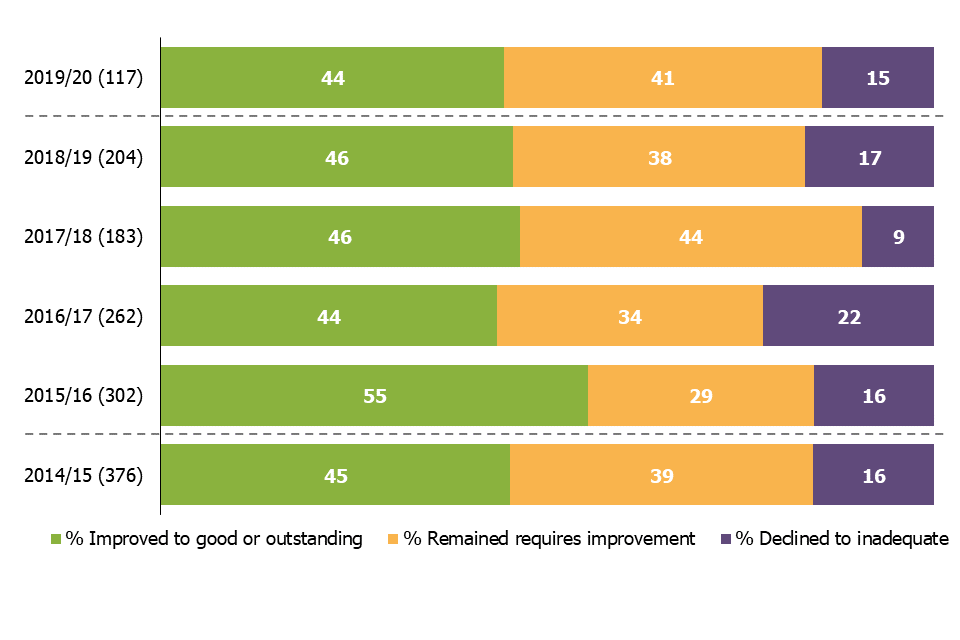Main findings: state-funded schools inspections and outcomes as at 31 March 2020
Published 30 June 2020
Applies to England
This is the main findings report for the state-funded schools and inspections and outcomes as at 31 March 2020 release. The following are also available:
- underlying data
- methodology
- pre-release access list
Summary
This release includes:
- schools’ most recent inspections and outcomes as at 31 March 2020
- provisional data for inspections completed between 1 January and 31 March 2020
- revised data for inspections completed between 1 September 2019 and 31 December 2019
Impact of coronavirus (COVID-19) on this release
All routine inspections and the publication of inspection reports were suspended in March 2020 due to COVID-19. Urgent inspections where specific concerns have been raised are still going ahead.
We normally publish inspection reports within 30 working days of the completion of the inspection. This release would normally include all inspections completed by 31 March 2020 and published by 30 April 2020. However, because we have suspended publishing routine inspection reports, there are some inspections excluded from this release. The suspension has had a minimal effect on the overall grades or messages in this publication.
Introduction
Seventy-eight per cent of schools have been judged good or outstanding this academic year.
Of the schools that were judged inadequate or to require improvement, 75% had a more positive judgement for personal development.
Eighty-four per cent of the previously good schools inspected this year remained good and 3% became outstanding.
Figure 1: Grade movement for schools previously judged to be good, by year

- - - A new inspection framework (EIF) was introduced in September 2019
Schools at their most recent inspection
Eighty-six per cent of all schools are good or outstanding. The percentage of schools judged good or outstanding has remained the same since August 2018. In this same period, the percentage of schools judged outstanding has declined from 21% to 19%, while the percentage of schools judged good has increased from 65% to 67%.
Figure 2: Overall effectiveness of state-funded schools at their most recent inspection, by year

- - - There were changes to the inspection framework in January 2012, September 2012, September 2015 and September 2019.
More primary schools are good or outstanding than secondary schools: 88% compared with 76%. This is an increase of 1 percentage point for primary schools compared with last year, while the figure for secondary schools remains unchanged. Additionally, 98% of nursery schools (no change from August 2019), 91% of special schools (compared with 92% last year) and 85% of pupil referral units (PRUs) (compared with 83% last year) are good or outstanding.
Inspections between 1 September 2019 and 31 March 2020
This academic year, 78% of schools have been judged good or outstanding for overall effectiveness.
In this academic year, we have carried out:
- 1,316 section 5 inspections, including section 8 inspections of good and non-exempt outstanding schools and monitoring visits that became section 5 inspections
- 1,165 inspections of good and non-exempt outstanding schools that did not convert to a section 5 inspection
This year, 78% of schools have been judged good or outstanding for overall effectiveness, a decrease from 80% last year. The percentage judged outstanding has decreased by 3 percentage points compared with last year, while the percentage judged good remains the same.
These small differences between the 2 years are likely to be due to the different mix of schools inspected each year. A slightly higher proportion of last year’s inspections were visits to schools previously judged to be good or outstanding.
Inspections of schools previously judged to be good
Eighty-four per cent of the previously good schools inspected this year remained good and 3% became outstanding.
We have carried out 1,573 section 5 and section 8 inspections of previously good schools this year. Of these, 84% remained good, 3% became outstanding, 11% now require improvement and 2% became inadequate.
Between 2014/15 and 2018/19, the proportion of previously good schools remaining good or improving to outstanding increased each year. This year, there has been a decrease of 1 percentage point from 87% last year to 86% this year.
Figure 3: Grade movement for schools previously judged to be good, by year

- - - A new inspection framework (EIF) was introduced in September 2019.
Secondary schools have the highest proportion of schools that declined to requires improvement or inadequate, at 23%.
Figure 4: Grade movement in 2019/20 for schools previously judged to be good, by phase

Only 1% of section 8 inspections of good schools converted to section 5 inspections. Of those that did not convert, 17% indicated that the school might decline at a section 5 inspection (compared with 11% last year) and 5% indicated that the school might improve (compared with 12% last year).
Inspections of schools previously judged to require improvement
This year, 57% of schools inspected that previously required improvement improved to good, compared with 64% last year.
We have carried out 517 section 5 inspections this year of schools that were previously judged to require improvement. This year, 57% of schools inspected improved from requires improvement to good, compared with 64% last year. A further 36% remained requires improvement, an increase from 27% last year.
Figure 5: Grade movement for schools previously judged to require improvement, by year

- - - There were changes to the inspection framework in September 2015 and September 2019.
Primary schools previously judged to require improvement are more likely to improve to good or outstanding than secondary schools, with 62% improving their grade this year compared with 44% of secondary schools. This pattern is true across each of the last 5 academic years.
Figure 6: Grade movement for primary schools previously judged to require improvement, by year

- - - There were changes to the inspection framework in September 2015 and September 2019.
Figure 7: Grade movement for secondary schools previously judged to require improvement, by year

- - - There were changes to the inspection framework in September 2015 and September 2019.
Changes in overall effectiveness grades
Overall, 82% of schools inspected this year have either retained or improved on their previous overall effectiveness grade (this includes schools who had a section 8 inspection that did not convert to a section 5 inspection). This ranges from 94% of nurseries, to 77% of secondary schools. Within this, 65% of schools kept the same grade as at their previous inspection, the same proportion as last year.
Figure 8: Change in overall effectiveness of schools inspected in 2019/20, by phase

Overall, this is a fairly stable picture, with nearly two thirds of schools keeping the same grade under the education inspection framework (EIF), and as many schools improving as declining. After 7 months of inspections, the overall proportion of all schools graded good or outstanding at their most recent inspection is unchanged and remains at 86%, the same proportion as in August 2019.
The relationship between the inspection judgements
Of the schools that were judged inadequate or to require improvement, 75% had a more positive judgement for personal development.
When we inspect schools, we make 4 other judgements in addition to the overall effectiveness judgement.[footnote 1] Often, the outcome of the other judgements matches the overall effectiveness outcome. However, in some cases, the outcome of the other judgements may be higher or lower than overall effectiveness.
Compared with the overall effectiveness judgement, of the schools that we inspected this year:
- 41% had a higher outcome for personal development
- 33% had a higher outcome for behaviour and attitudes
- 11% had a higher outcome for effectiveness of leadership and management
- 2% had a higher outcome for quality of education
Table 1: The percentage of inspected schools when an inspection judgement was graded higher than overall effectiveness, by phase
| Ofsted phase | Quality of education | Behaviour and attitudes | Personal development | Effectiveness of leadership and management |
|---|---|---|---|---|
| All schools | 2 | 33 | 41 | 11 |
| Nursery | 0 | 47 | 29 | 6 |
| Primary | 1 | 35 | 40 | 10 |
| Secondary | 7 | 24 | 45 | 16 |
| Special | 2 | 38 | 53 | 17 |
| PRU | 0 | 21 | 32 | 11 |
Schools that we judged to be inadequate or to require improvement are the most likely to have another judgement that is higher than their overall effectiveness judgement. Seventy-six per cent of inadequate schools were judged higher than inadequate for personal development, and 74% of schools judged to require improvement were judged to be good or outstanding for personal development.
Table 2: The percentage of inspected schools when an inspection judgement was graded higher than overall effectiveness, by overall effectiveness grade
| Overall effectiveness | Quality of education | Behaviour and attitudes | Personal development | Effectiveness of leadership and management |
|---|---|---|---|---|
| All schools | 2 | 33 | 41 | 11 |
| Outstanding | 0 | 0 | 0 | 0 |
| Good | 0 | 12 | 17 | 3 |
| Requires improvement | 1 | 64 | 74 | 25 |
| Inadequate | 16 | 49 | 76 | 12 |
Revisions to previous release
The provisional data in the previous release relates to inspections that took place between 1 September 2019 and 31 December 2019, with the reports published by 31 January 2020. We provide revised data for inspections in this period in tables 1R and 2R of the Excel file accompanying this release: State-funded schools inspections and outcomes as at 31 March 2020, charts and tables.
This revised data includes an additional 23 section 5 inspections that had not been published by 31 January 2020 but were published by 30 April 2020. These inspections resulted in the following number of additional judgements at each overall effectiveness grade:
- 1 outstanding
- 2 good
- 4 requires improvement
- 16 inadequate
Therefore, the proportion of all schools judged good between 1 September 2019 and 31 December 2019 changed from 52% to 51%, the proportion that require improvement from 37% to 36% and the proportion judged inadequate from 6% to 8%.
For primary schools, the proportion judged good changed from 56% to 55% and the proportion judged inadequate from 4% to 5%.
For secondary schools, the proportion judged good changed from 41% to 40%, the proportion that require improvement from 45% to 43% and the proportion judged inadequate from 10% to 15%.
For nursery schools, the proportion judged outstanding changed from 40% to 36%, the proportion judged good from 50% to 45%, the proportion that require improvement from 10% to 9% and the proportion judged inadequate from 0% to 9%.
For special schools, the proportion judged outstanding changed from 14% to 15%, the proportion judged good from 33% to 31% and the proportion that require improvement from 25% to 26%.
We publish revisions to data in this publication in line with our revisions policy for official statistics.
Notes
The purpose of these official statistics is to disseminate the data on school standards collected through Ofsted’s role as an inspectorate. They provide information about how the judgements of schools have changed over time. They vary across different phases of education and different parts of the country.
This official statistics release reports on the outcomes of state-funded school inspections carried out under sections 5 or 8 of the Education Act 2005. We carried out these inspections between 1 September 2019 and 31 March 2020. This release also includes the most recent inspections and outcomes for all schools that we have inspected, as at 31 March 2020.
Throughout this release, we use the term ‘schools’ to cover all local authority-maintained schools, state-funded academies and non-maintained special schools in England that section 5 of the Education Act 2005 requires us to inspect.
We carried out inspections between September 2015 and August 2019 under the common inspection framework: common inspection framework.
From September 2019, we carry out inspections under the EIF.
You can find an explanation of the main uses of this data, further contextual information and the arrangements for quality assurance in the methodology report. This report provides information about strengths and limitations of the statistics.
Where percentages are quoted in this report, figures have been rounded and may not add to 100.
Section 5 and section 8
Ofsted carries out inspections under sections 5 and 8 of the Education Act 2005.
We are required to inspect at prescribed intervals all schools to which section 5 applies. The regulations set the interval for section 5 inspections ‘within 5 school years from the end of the school year in which the last inspection took place’. The exceptions to this requirement are schools that are exempt from section 5 inspection (known as ‘exempt schools’).
Section 8 enables Her Majesty’s Chief Inspector (HMCI) to carry out inspections for a range of purposes. This includes monitoring visits by Her Majesty’s Inspectors (HMI) to schools that are in a category of concern following a section 5 inspection. HMI may also visit schools to aid HMCI in keeping the Secretary of State informed or to contribute to reports on, for example, the teaching in a curriculum subject or a particular aspect of the work of schools. Section 8 is also used to enable HMCI, if they have concerns, to carry out an inspection of those outstanding schools that are exempt from routine inspection under section 5.
Inspections carried out under section 8 include:
- section 8 inspections of schools judged to be good at their most recent section 5 inspection and those outstanding schools that are not exempt from section 5
- monitoring inspections of schools judged as requires improvement, having serious weaknesses or requiring special measures
- any inspection carried out in other circumstances if the inspection has no specific designation
- unannounced behaviour inspections
Section 8 inspections of schools judged to be good at their most recent section 5 inspection and those outstanding schools that are not exempt from section 5
These section 8 inspections are usually either a 1- or 2- day inspection and take place approximately every 4 years. The section 8 inspection determines whether the school continues to provide the same good or outstanding standard of education for pupils. The inspection does not result in individual graded judgements nor does it change the overall effectiveness grade of the school. If there are serious concerns, the section 8 inspection is converted to a section 5 inspection, when inspectors will make the full set of graded judgements.
From November 2017, some previously good schools are subject to a section 5 inspection instead of a section 8 inspection if our risk assessment tells us that a section 8 inspection would be highly likely to convert. For example, this applies if a school underwent significant change, such as changing its age range, or if the quality of provision may have deteriorated significantly.
From January 2018, section 8 inspections are only converted to a section 5 inspection if there are serious concerns. If a section 8 inspection does not convert, there are additional outcomes if the school remains either good or outstanding, but the next inspection will be a section 5 inspection.
Glossary
Definitions of terms are within the statistical glossary
Further information
Contacts
If you are a member of the public and have any comments or feedback on this publication, contact Louise Butler on 03000 131 457 or the schools data and analysis team on [email protected].
Press enquiries should be sent to our press team at [email protected].
Acknowledgements
Thanks to the following for their contribution to this statistical release: Clair Simpson, Matthew Spencer, James Jordan and Mundeep Gill.
Instructions for printing and saving
Depending on which browser you use, such as Internet Explorer or Google Chrome, and the type of device you use, such as an iPhone or laptop, these instructions may vary.
You will find your print and save options in your browser’s menu. You may also have other options available on your device. Tablets and mobile device instructions will be specific to the make and model of the device.
How to search
Click on Ctrl + F on a Windows laptop or Command + F on a Mac
This will open a search box in the top right-hand corner of the page. Type the word you are looking for in the search bar and press enter.
Your browser will highlight the word, usually in yellow, wherever it appears on the page. Press enter to move to the next place it appears.
How to print a copy of the guidance
Click on Ctrl + P on a Windows laptop or Command + P on a Mac
You can also choose to save as a PDF.
-
Since September 2019, we now make judgements about the quality of education, behaviour and attitudes, personal development and the effectiveness of leadership and management. ↩

